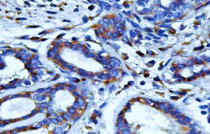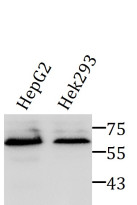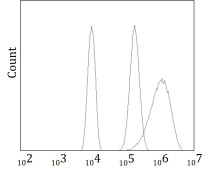ARG43817
anti-Occludin antibody
anti-Occludin antibody for Flow cytometry,ICC/IF,IHC-Formalin-fixed paraffin-embedded sections,Western blot and Human
Overview
| Product Description | Rabbit Polyclonal antibody recognizes Occludin |
|---|---|
| Tested Reactivity | Hu |
| Tested Application | FACS, ICC/IF, IHC-P, WB |
| Host | Rabbit |
| Clonality | Polyclonal |
| Isotype | IgG |
| Target Name | Occludin |
| Antigen Species | Human |
| Immunogen | Synthetic peptide of human occludin. |
| Conjugation | Un-conjugated |
| Alternate Names | PPP1R115; BLCPMG; Occludin |
Application Instructions
| Application Suggestion |
|
||||||||||
|---|---|---|---|---|---|---|---|---|---|---|---|
| Application Note | IHC-P: Antigen Retrieval: Boil tissue section in 10mM citrate buffer, pH 6.0 for 10 min followed by cooling at RT for 20 min. Incubation Time: 30 min at RT. * The dilutions indicate recommended starting dilutions and the optimal dilutions or concentrations should be determined by the scientist. |
Properties
| Form | Liquid |
|---|---|
| Purification | Immunogen affinity purified |
| Preservative | 0.01mg Sodium azide |
| Stabilizer | 4mg Trehalose, 0.9mg NaCl and 0.2mg and Na2HPO4 |
| Concentration | 0.5 mg/ml |
| Storage Instruction | For continuous use, store undiluted antibody at 2-8°C for up to a week. For long-term storage, aliquot and store at -20°C or below. Storage in frost free freezers is not recommended. Avoid repeated freeze/thaw cycles. Suggest spin the vial prior to opening. The antibody solution should be gently mixed before use. |
| Note | For laboratory research only, not for drug, diagnostic or other use. |
Bioinformation
| Database Links | |
|---|---|
| Gene Symbol | OCLN |
| Gene Full Name | occludin |
| Background | This gene encodes an integral membrane protein that is required for cytokine-induced regulation of the tight junction paracellular permeability barrier. Mutations in this gene are thought to be a cause of band-like calcification with simplified gyration and polymicrogyria (BLC-PMG), an autosomal recessive neurologic disorder that is also known as pseudo-TORCH syndrome. Alternative splicing results in multiple transcript variants. A related pseudogene is present 1.5 Mb downstream on the q arm of chromosome 5. [provided by RefSeq, Apr 2011] |
| Function | May play a role in the formation and regulation of the tight junction (TJ) paracellular permeability barrier. It is able to induce adhesion when expressed in cells lacking tight junctions. [UniProt] |
| Cellular Localization | Membrane |
| Highlight | Related products: Occludin antibodies; Occludin Duos / Panels; Anti-Rabbit IgG secondary antibodies; |
| Calculated MW | 59 kDa |
| PTM | Dephosphorylated by PTPRJ. The tyrosine phosphorylation on Tyr-398 and Tyr-402 reduces its ability to interact with TJP1. Phosphorylation at Ser-490 also attenuates the interaction with TJP1. |
Images (4) Click the Picture to Zoom In
-
ARG43817 anti-Occludin antibody IHC-P image
Immunohistochemistry: Paraffin-embedded human mammary cancer tissue stained with ARG43817 anti-Occludin antibody.
-
ARG43817 anti-Occludin antibody ICC/IF image
Immunofluorescence: A431 cells stained with ARG43817 anti-Occludin antibody at 1:100 dilution.
-
ARG43817 anti-Occludin antibody WB image
Western blot: HepG2 and HEK293 cell stained with ARG43817 anti-Occludin antibody at 1:1000 dilution.
-
ARG43817 anti-Occludin antibody FACS image
Flow Cytometry: U20S cells stained with ARG43817 anti-Occludin antibody at 1:100/1x10^6 cells dilution.









